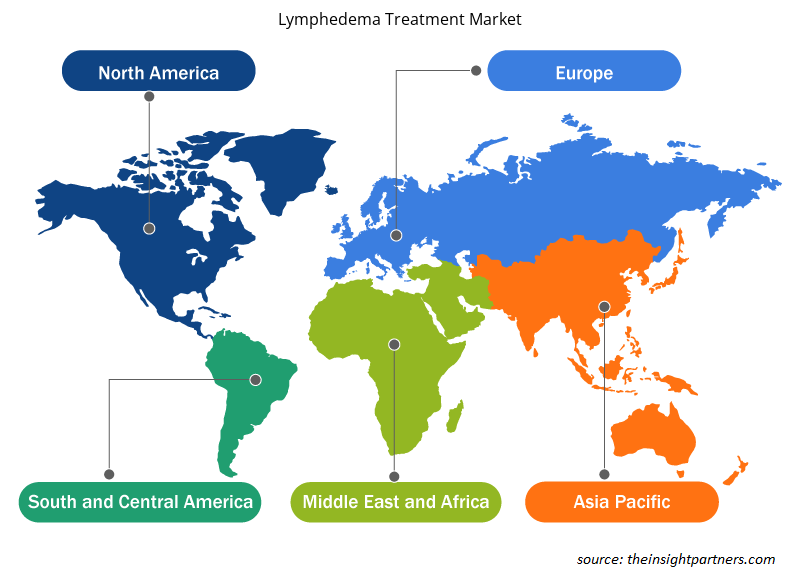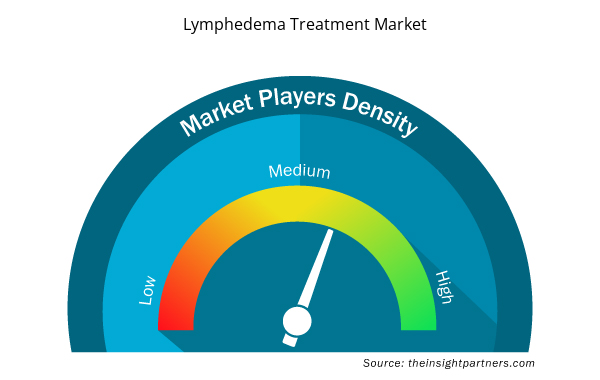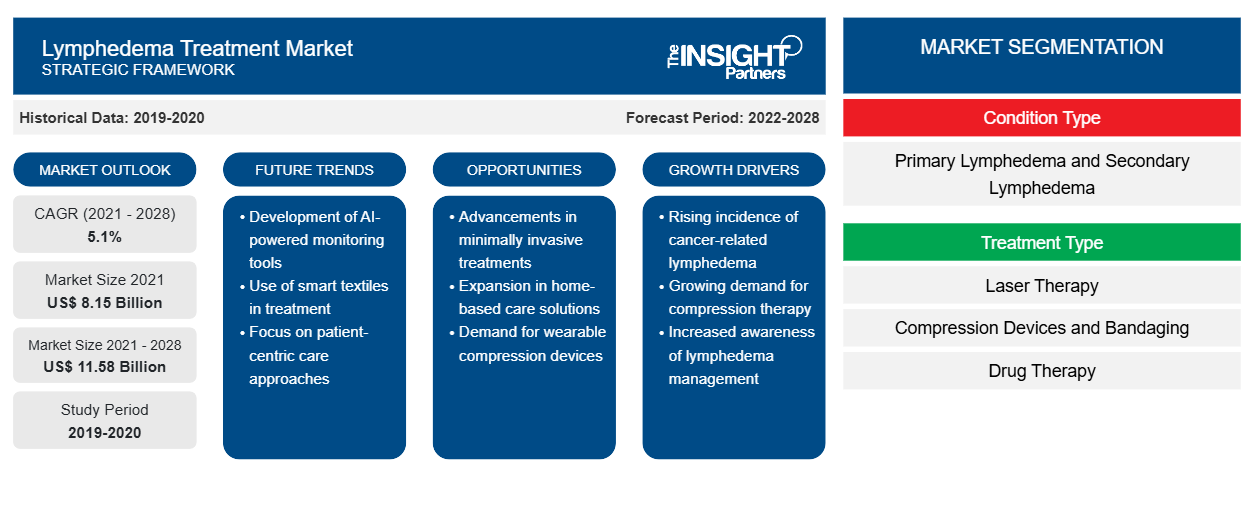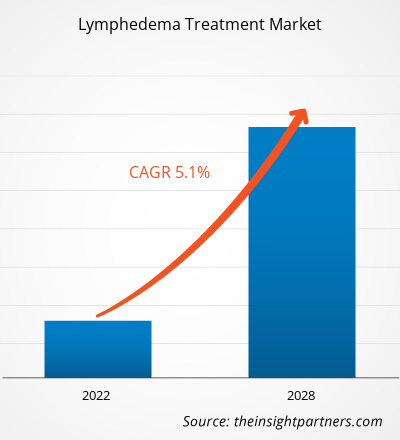Si prevede che il mercato del trattamento del linfedema raggiungerà gli 11,58 miliardi di dollari entro il 2028, rispetto agli 8,15 miliardi di dollari del 2021; si prevede una crescita a un CAGR del 5,1% dal 2021 al 2028.
Il linfedema è una condizione in cui il corpo si allarga in modo anomalo a causa della linfostasi causata da disfunzione del sistema linfatico. Colpisce più comunemente l'estremità inferiore (90%), l'estremità superiore (10%) e i genitali (1%). Il linfedema primario è presente alla nascita, mentre il linfedema secondario è causato da inefficienza o danni al sistema linfatico. Il linfedema secondario si sviluppa frequentemente dopo il trattamento del cancro. Il linfedema è causato da ostruzioni nel passaggio del fluido linfatico causate da intervento chirurgico, radioterapia o crescita del cancro. Le sensazioni di tensione o pesantezza; gonfiore a gambe, braccia o altre parti del corpo; dolore o disagio; e fibrosi, che ispessisce o indurisce la pelle, sono tra i sintomi comuni del linfedema.
Personalizza questo report in base alle tue esigenze
Riceverai la personalizzazione gratuita di qualsiasi report, comprese parti di questo report, o analisi a livello nazionale, pacchetto dati Excel, oltre a usufruire di grandi offerte e sconti per start-up e università
- Scopri le principali tendenze di mercato in questo rapporto.Questo campione GRATUITO includerà analisi di dati che spaziano dalle tendenze di mercato alle stime e alle previsioni.
La crescita del mercato del trattamento del linfedema è attribuita alla crescente incidenza del linfedema e al crescente numero di programmi di gestione del linfedema con un'impennata nella promozione dei servizi di telemedicina in vari paesi. Tuttavia, la mancanza di professionisti qualificati e gli elevati costi chirurgici nelle economie in via di sviluppo ostacolano la crescita del mercato.
Approfondimenti di mercato
Aumento dei casi di linfedema
Secondo il Dipartimento della Salute e dei Servizi Umani degli Stati Uniti, il linfedema può verificarsi nei pazienti oncologici all'insorgenza della malattia o dopo il suo trattamento, che influisce sul drenaggio dei linfonodi. Ad esempio, è stato segnalato che può verificarsi entro pochi giorni e fino a 30 anni dopo il trattamento per il cancro al seno . Inoltre, l'80% dei pazienti sperimenta l'insorgenza entro 3 anni dall'intervento chirurgico e il resto sviluppa edema a un tasso dell'1% all'anno. Inoltre, un ampio bacino di pazienti, in particolare donne, soffre di linfedema degli arti inferiori dopo il trattamento del cancro ginecologico, con la prevalenza più elevata (37%) tra le sopravvissute al cancro vulvare e la prevalenza più bassa (7%) tra le sopravvissute al cancro ovarico. Inoltre, l'incidenza complessiva del linfedema del braccio varia dall'8% al 56% a due anni dall'intervento chirurgico. Il sottostudio longitudinale Alliance Z 1071 dell'American College of Surgeons Oncology Group (ACOSOG) afferma che negli studi sul cancro al seno, i pazienti segnalano un'incidenza cumulativa di 3 anni di gonfiore e pesantezza del braccio. Le opzioni di trattamento del cancro altamente efficaci e avanzate aiutano a ridurre al minimo il rischio di linfedema. Pertanto, i principali attori del mercato delle terapie contro il cancro sono fortemente concentrati sul lancio di prodotti innovativi.
Informazioni basate sul tipo di condizione
In base al tipo di condizione, il mercato globale del trattamento del linfedema è stato segmentato in linfedema primario e linfedema secondario. Il segmento del linfedema secondario ha detenuto una quota maggiore del mercato nel 2021. Tuttavia, si prevede che il segmento del linfedema primario registrerà un CAGR più elevato nel mercato durante il periodo di previsione. L'attuale crescita del mercato del segmento del linfedema secondario è attribuita al fatto che il trattamento del cancro è una causa importante di linfedema secondario e la maggior parte delle persone che soffrono di linfedema secondario sono elevate nei paesi in via di sviluppo e sviluppati.
Tipo di trattamento - Approfondimenti basati
In base al tipo di trattamento, il mercato globale del trattamento del linfedema è stato segmentato in terapia laser , dispositivi di compressione e bendaggi, terapia farmacologica, procedure fisiologiche, procedure di debulking e altri. Il segmento delle procedure fisiologiche è ulteriormente segmentato in anastomosi linfovenosa (LVA) e trasferimento del linfonodo vascolarizzato (VLNT). Inoltre, il segmento delle procedure di debulking è sottosegmentato come debulking chirurgico, liposuzione e altri. Il segmento dei dispositivi di compressione e dei bendaggi ha rappresentato la quota di mercato maggiore nel 2021. Le aziende nel mercato del trattamento del linfedema stanno sviluppando diversi tipi di indumenti compressivi e stanno promuovendo prodotti convenienti. Inoltre, si prevede che il segmento delle procedure fisiologiche registrerà il CAGR più elevato nel mercato durante il periodo di previsione.
Approfondimenti regionali sul mercato del trattamento del linfedema
Le tendenze regionali e i fattori che influenzano il mercato del trattamento del linfedema durante il periodo di previsione sono stati ampiamente spiegati dagli analisti di Insight Partners. Questa sezione discute anche i segmenti e la geografia del mercato del trattamento del linfedema in Nord America, Europa, Asia Pacifico, Medio Oriente e Africa e America meridionale e centrale.

- Ottieni i dati specifici regionali per il mercato del trattamento del linfedema
Ambito del rapporto di mercato sul trattamento del linfedema
| Attributo del report | Dettagli |
|---|---|
| Dimensioni del mercato nel 2021 | 8,15 miliardi di dollari USA |
| Dimensioni del mercato entro il 2028 | 11,58 miliardi di dollari USA |
| CAGR globale (2021 - 2028) | 5,1% |
| Dati storici | 2019-2020 |
| Periodo di previsione | 2022-2028 |
| Segmenti coperti | Per tipo di condizione
|
| Regioni e Paesi coperti | America del Nord
|
| Leader di mercato e profili aziendali chiave |
|
Densità degli attori del mercato del trattamento del linfedema: comprendere il suo impatto sulle dinamiche aziendali
Il mercato del trattamento del linfedema sta crescendo rapidamente, spinto dalla crescente domanda degli utenti finali dovuta a fattori quali l'evoluzione delle preferenze dei consumatori, i progressi tecnologici e una maggiore consapevolezza dei benefici del prodotto. Con l'aumento della domanda, le aziende stanno ampliando le loro offerte, innovando per soddisfare le esigenze dei consumatori e capitalizzando sulle tendenze emergenti, il che alimenta ulteriormente la crescita del mercato.
La densità degli operatori di mercato si riferisce alla distribuzione di aziende o società che operano in un particolare mercato o settore. Indica quanti concorrenti (operatori di mercato) sono presenti in un dato spazio di mercato in relazione alle sue dimensioni o al valore di mercato totale.
Le principali aziende che operano nel mercato del trattamento del linfedema sono:
- Sistemi di biocompressione
- Soluzioni mediche Essity
- Gruppo L & R
- Sigvari
- Medicina tattile
Disclaimer : le aziende elencate sopra non sono classificate secondo un ordine particolare.

- Ottieni una panoramica dei principali attori del mercato del trattamento del linfedema
Informazioni basate sull'utente finale
In base all'utente finale, il mercato globale del trattamento del linfedema è stato segmentato in ospedali, cliniche, organizzazioni di ricerca clinica (CRO) e altri (centri di assistenza ambulatoriale e centri di assistenza primaria). Il segmento degli ospedali ha catturato la quota di mercato più grande nel 2021. Si prevede che il segmento delle cliniche registrerà il CAGR più elevato durante il periodo di previsione; la crescita di mercato di questo segmento può essere attribuita al fatto che i trattamenti del linfedema sono offerti principalmente in centri o unità specializzati. I trattamenti chirurgici specializzati come la liposuzione e le procedure di debulking hanno luogo in cliniche specialistiche che hanno un reparto dedicato alla neurologia o, più specificamente, al trattamento del linfedema.
I lanci e le approvazioni di prodotti sono strategie comunemente adottate dalle aziende nel mercato del trattamento del linfedema per espandere la loro presenza globale e i loro portafogli di prodotti. Inoltre, gli operatori di mercato si concentrano sulla strategia di partnership per espandere la loro clientela, il che, a sua volta, consente loro di mantenere il loro marchio in tutto il mondo.
Profili aziendali
- SISTEMI DI BIOCOMPRESSIONE
- Medicina tattile
- Fabbro e nipote
- BSN Medical GmbH
- Lohmann & Rauscher GmbH & Co. KG
- GRUPPO SIGVARIS
- Termotek
- Assistenza sanitaria limitata Huntleigh
- 3 milioni
- Mego Afek Ltd.
- Analisi storica (2 anni), anno base, previsione (7 anni) con CAGR
- Analisi PEST e SWOT
- Valore/volume delle dimensioni del mercato - Globale, regionale, nazionale
- Industria e panorama competitivo
- Set di dati Excel


- Water Pipeline Leak Detection System Market
- Volumetric Video Market
- EMC Testing Market
- Digital Pathology Market
- Excimer & Femtosecond Ophthalmic Lasers Market
- Intradermal Injection Market
- Employment Screening Services Market
- Rugged Phones Market
- Arterial Blood Gas Kits Market
- Airport Runway FOD Detection Systems Market

Report Coverage
Revenue forecast, Company Analysis, Industry landscape, Growth factors, and Trends

Segment Covered
This text is related
to segments covered.

Regional Scope
North America, Europe, Asia Pacific, Middle East & Africa, South & Central America

Country Scope
This text is related
to country scope.
Domande frequenti
BIOCOMPRESSION SYSTEMS; Tactile Medical; Smith and Nephew; BSN Medical GmbH; Lohmann & Rauscher GmbH & Co. KG; SIGVARIS GROUP; ThermoTek; Huntleigh Healthcare Limited; 3M; Mego Afek Ltd. are among the key companies operating in the lymphedema treatment market.
The market is estimated to grow with a CAGR of 5.1% from 2021 to 2028.
Key factors that are driving the growth of the market are increasing incidences of lymphedema and programs conducted by the government fuel the growth of the market.
Lymphedema treatment mainly refers to the treatment options that are used in combatting primary and secondary lymphedema disease conditions. Some of the treatment types that are considered in the process include laser therapy, debulking procedures, liposuction, lymph node transfer, compression, and bandaging devices.
Trends and growth analysis reports related to Life Sciences : READ MORE..
The List of Companies - Lymphedema Treatment Market
- Biocompression Systems
- Essity Medical Solutions
- L & R Group
- SIGVARIS
- Tactile Medical
- SMITH + NEPHEW
- Thermo Tek
- Huntleigh Healthcare Limited.
- Physiopedia
- AIROS Medical, Inc.
The Insight Partners performs research in 4 major stages: Data Collection & Secondary Research, Primary Research, Data Analysis and Data Triangulation & Final Review.
- Data Collection and Secondary Research:
As a market research and consulting firm operating from a decade, we have published and advised several client across the globe. First step for any study will start with an assessment of currently available data and insights from existing reports. Further, historical and current market information is collected from Investor Presentations, Annual Reports, SEC Filings, etc., and other information related to company’s performance and market positioning are gathered from Paid Databases (Factiva, Hoovers, and Reuters) and various other publications available in public domain.
Several associations trade associates, technical forums, institutes, societies and organization are accessed to gain technical as well as market related insights through their publications such as research papers, blogs and press releases related to the studies are referred to get cues about the market. Further, white papers, journals, magazines, and other news articles published in last 3 years are scrutinized and analyzed to understand the current market trends.
- Primary Research:
The primarily interview analysis comprise of data obtained from industry participants interview and answers to survey questions gathered by in-house primary team.
For primary research, interviews are conducted with industry experts/CEOs/Marketing Managers/VPs/Subject Matter Experts from both demand and supply side to get a 360-degree view of the market. The primary team conducts several interviews based on the complexity of the markets to understand the various market trends and dynamics which makes research more credible and precise.
A typical research interview fulfils the following functions:
- Provides first-hand information on the market size, market trends, growth trends, competitive landscape, and outlook
- Validates and strengthens in-house secondary research findings
- Develops the analysis team’s expertise and market understanding
Primary research involves email interactions and telephone interviews for each market, category, segment, and sub-segment across geographies. The participants who typically take part in such a process include, but are not limited to:
- Industry participants: VPs, business development managers, market intelligence managers and national sales managers
- Outside experts: Valuation experts, research analysts and key opinion leaders specializing in the electronics and semiconductor industry.
Below is the breakup of our primary respondents by company, designation, and region:

Once we receive the confirmation from primary research sources or primary respondents, we finalize the base year market estimation and forecast the data as per the macroeconomic and microeconomic factors assessed during data collection.
- Data Analysis:
Once data is validated through both secondary as well as primary respondents, we finalize the market estimations by hypothesis formulation and factor analysis at regional and country level.
- Macro-Economic Factor Analysis:
We analyse macroeconomic indicators such the gross domestic product (GDP), increase in the demand for goods and services across industries, technological advancement, regional economic growth, governmental policies, the influence of COVID-19, PEST analysis, and other aspects. This analysis aids in setting benchmarks for various nations/regions and approximating market splits. Additionally, the general trend of the aforementioned components aid in determining the market's development possibilities.
- Country Level Data:
Various factors that are especially aligned to the country are taken into account to determine the market size for a certain area and country, including the presence of vendors, such as headquarters and offices, the country's GDP, demand patterns, and industry growth. To comprehend the market dynamics for the nation, a number of growth variables, inhibitors, application areas, and current market trends are researched. The aforementioned elements aid in determining the country's overall market's growth potential.
- Company Profile:
The “Table of Contents” is formulated by listing and analyzing more than 25 - 30 companies operating in the market ecosystem across geographies. However, we profile only 10 companies as a standard practice in our syndicate reports. These 10 companies comprise leading, emerging, and regional players. Nonetheless, our analysis is not restricted to the 10 listed companies, we also analyze other companies present in the market to develop a holistic view and understand the prevailing trends. The “Company Profiles” section in the report covers key facts, business description, products & services, financial information, SWOT analysis, and key developments. The financial information presented is extracted from the annual reports and official documents of the publicly listed companies. Upon collecting the information for the sections of respective companies, we verify them via various primary sources and then compile the data in respective company profiles. The company level information helps us in deriving the base number as well as in forecasting the market size.
- Developing Base Number:
Aggregation of sales statistics (2020-2022) and macro-economic factor, and other secondary and primary research insights are utilized to arrive at base number and related market shares for 2022. The data gaps are identified in this step and relevant market data is analyzed, collected from paid primary interviews or databases. On finalizing the base year market size, forecasts are developed on the basis of macro-economic, industry and market growth factors and company level analysis.
- Data Triangulation and Final Review:
The market findings and base year market size calculations are validated from supply as well as demand side. Demand side validations are based on macro-economic factor analysis and benchmarks for respective regions and countries. In case of supply side validations, revenues of major companies are estimated (in case not available) based on industry benchmark, approximate number of employees, product portfolio, and primary interviews revenues are gathered. Further revenue from target product/service segment is assessed to avoid overshooting of market statistics. In case of heavy deviations between supply and demand side values, all thes steps are repeated to achieve synchronization.
We follow an iterative model, wherein we share our research findings with Subject Matter Experts (SME’s) and Key Opinion Leaders (KOLs) until consensus view of the market is not formulated – this model negates any drastic deviation in the opinions of experts. Only validated and universally acceptable research findings are quoted in our reports.
We have important check points that we use to validate our research findings – which we call – data triangulation, where we validate the information, we generate from secondary sources with primary interviews and then we re-validate with our internal data bases and Subject matter experts. This comprehensive model enables us to deliver high quality, reliable data in shortest possible time.


 Ottieni un campione gratuito per questo repot
Ottieni un campione gratuito per questo repot